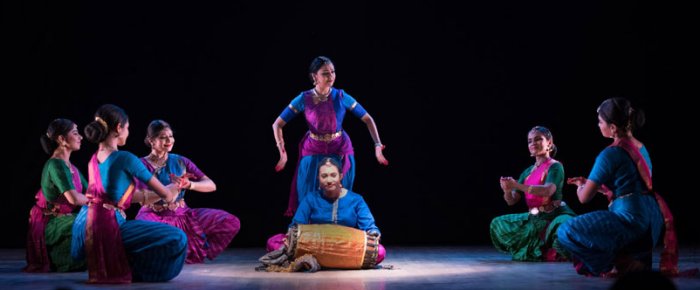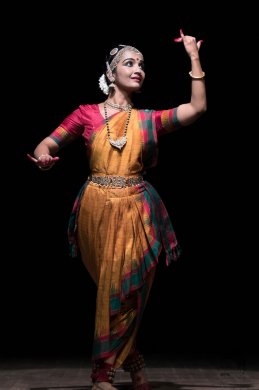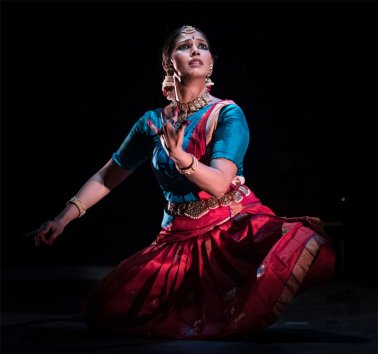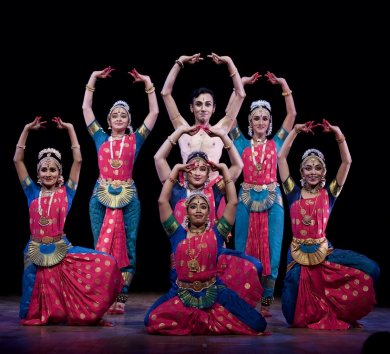
|   |

|   |
A festival for the artists by the artists - Satish Suri e-mail: satishism@yahoo.co.in Photos: Jayasimha Reddy November 10, 2018 The crowd-funded two day festival by Diya Performing Arts was a resounding success both in terms of its content as well as the audience response. The opening day clearly belonged to Rama Vaidyanathan and her ensemble with their presentation of 'Vivartana' which looks at how dance transforms us and explores the long-standing association of the choreographer with Bharatanatyam.  Vivartana The curtain opened to SannidhiVaidyanathan taking centre stage and playing the mridangam. As the tonal beats resounded, dancers Dakshina Vaidyanathan Baghel, Rohini Dhananjaya, Lakshmi Chakyar, Meera Unnithan and Kavya Ganesh entered the stage performing several adavaus and moving to the perfect rhythm of the beats around the mridangam. The tempo scaled up, and Rama Vaidyanathan made an appearance on stage to thunderous applause of the audience. She provided the first imprint "Pratikriya" (dance responds) of the five segmental productions through the exploration of a poem penned by her and translated into Sanskrit by Divyanand Jha. The next segment featured Samayoga (dance merges) performed as a solo by Rama Vaidyanathan, providing an insight into the energy of the dancer and the breath associated with it. The music composition of Dr.S.Vasudevan with verses from "Tirumandiram," by Tirumalar provided the dancer with a landscape of variegated expressions culminating in the Ananda Tandava. Nimagna (dance immerses),was a creative exploration of the total immersion of dance invoking verses from Rumi, Meera Bai, Kashmiri poet Lalleswari and Dikshitar. The dancer's template was a fine blend of pure and evocative expressions. Diksitar'composition"Ajapa Natanam" wherein Shiva is taken in procession in a palanquin provided an aesthetic interpretation and the movement profile by the dancers was enchanting. Prathibodhana (dance awakens) embraced the visual metaphor of the Gujarati poem by Narsinh Mehta describing the Raas Leela of Krishna and the Gopikas. The depiction by Rama of Krishna dressing up was delightfully engrossing. Rasabhava (dance evokes) drew its inspiration from Abhinaya Darpana of Nandikeswara, "yatho hasta tathodrishti..." Interpreting the shloka by the dancers in its entirety with jatis and fine facial expressions the narrative culminated with Rama joining them in the rendition of the "Rangadha Devatha Sthuthi," the embodiment of the joy of all sentiments and rasas that will charm the world. The music was on recorded track and credit must be given to the team of musicians Keerthana Vaidyanathan, Ranita De, Reshika Sivakumar (vocals), Sumod Sreedharan, Satish Krishnamurthy, Ganapathy Sundar, Sannidhi Vaidyanathan (percussion), Bhavani Shankar (veena), Rajat Prasanna (flute), Raghavendra (violin) and Ghulam Ali (sarangi), and Deepa Dharmadhikari (lights) who supported the production to provide the intensity. Last but not the least, Rama Vaidyanathan must be complimented for the research, innovative choreography and the diligent training given to the accompanying dancers who proved their mettle on stage. 
Shruti Gopal
The opening statement on the second day of the festival by Shruti Gopal established the artist's competence in her exquisite presentation of Lingaraj Urs's composition 'Sringara Lahari' in Neelambari, depicting the splendour and supremacy of the goddess, the consort of Shiva, with pure dance sequences that showed the technical prowess and clarity of line and movement of the artist.The delineation exemplified the fleetfooted grace of the idiom. The Kshetrayya padam "Nanne pendladu sumi" captured the spectrum of expressions of the nayika who is after Krishna to marry her. Her presentation seen through three different nayikas -mugda nayika, madhya nayika and pragalbha nayika - imbibed a lot of humour that qualified the sahitya. Prachi Saathi took to the stage next to describe the romantic archetypes of a woman in love. Titled 'Ashta Leela', the narrative amplifies the metaphor of the Divine Raas of the Gopikas with their Krishna through the verses of Surdas and marks the elevation and surrender of the mortal jeevatma with the immortal paramatma. Appropriate verses were chosen from Surdas and the choreographic inputs from Rama Vaidyanathan aided the artist in bringing out the nuances of love and different "avasthas" (states of mind of the nayika) beginning with Vasakasajja, where the nayika is embellishing herself with ornaments and ready to welcome her beloved; Virahotkanditha - overwhelmed by separation and lamenting the non-arrival of her beloved; Swadheena - always enjoys the association of her beloved who has imprinted his trust in her heart; Kalahantarita - feels remorseful due to separation from her beloved through quarrel and laments her deeds and separation; Khandita - feels offended her beloved enjoys the company of another girl and is angry and distressed; Vipralabdha - disappointed at her beloved not showing up on time and her distress as she has waited for long; Proshitabhartrika - as one who is neglectful of her appearance and has abandoned her ornaments and let her hair loose and constantly thinking of her husband's arrival; Abhisarika - overwhelmed with love she leaves behind her family and shame to go and meet her beloved. The Surdas verses chosen personified each of these avasthas and the intricate choreography and the kaleidoscopic representation of emotions expressed was executed with finesse and assurance, punctuated with nritta segments and jathis and orchestral support that embellished the narrative. Prachi Saathi concluded with the Raas wherein Krishna is seen consoling each one of the Gopis which found an expression that was lively and vibrant and the dancer's flair for abhinaya was explicit in the interpretation.  Prachi Saathi  Praveen Kumar & Chitkala ensemble The finale was an exhilarating presentation by Praveen Kumar and his Chithkala Ensemble. He and his team of dancers with Divya Hoskere, Hemalatha, Raksha, Siri Chandrasekhar, Navyashree, Nidhi and Raaga set the stage alight with a jatiswaram in Abhogi characterised with lively and meticulous footwork that throbbed with a vibration at every stage of its execution. The Shiva Stuthi "Tha thai enru aaduvaar" was lively with the delightful sync of rhythm and the landscape of the stage pulsated to the high energy of the dancers. The Dikshitar composition"Ardhanareeswaram" showcased the choreographic acumen of Praveen Kumar. The Shiva-Parvati unity in duality was full of innovative imagery, flawless footwork, aesthetic and exquisite stances and precision in movement with Praveen and Divya Hoskere excelling in the delineation. It would be an understatement to say that it was an exemplary performance. The javali 'Prematho natho mataladava," a solo by Praveen had a different take wherein Krishna is the anguished nayaka trying to coax and cajole an indifferent nayika. He thinks of the earlier warmth of welcome and niceties that heralded his arrival.What has happened now? Finally, the nayika submits to the wiles of Krishna. Praveen expounded with commendable flair and explicit conviction of the narrative leaving the stage with a flash of a twinkle of the eye. The Tillana of Dr.Balamuralikrishna was the highlight of the evening, laced with the splendour of nritta and the brilliance of expression that enraptured the audience. The two-day festival showcased dedicated and committed artists and was devoid of any felicitations or speeches. As Praveen Kumar remarked, he "participated in the festival because it was a festival for the artists by the artists." Kudos to Rohini Dhananjaya and her team for organising this festival. Bangalore based Satish Suri is an avid dance rasika besides being a life member of the Music and Arts Society. |